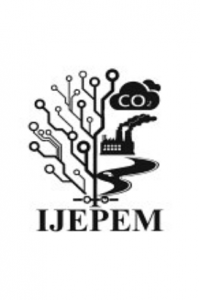Formula for Harmfulness of Cell Phone Waves for One Type of Pollution
Formula for Harmfulness of Cell Phone Waves for One Type of Pollution
___
- [1] Moorthy, C. Ganesa, G. Udhaya Sankar, and G. RajKumar. "A Design for Charging Section of Electrostatic Precipitators by Applying a Law for Electric Field Waves." Imperial Journal of Interdisciplinary Research 3.6 (2017): 842-844.
- [2] Moorthy, C. Ganesa, G. Udhaya Sankar, and Graj Kumar. "What Is The Polarity Of An Electromagnetic Wave?." Indian J. Sci. Res 13.1 (2017): 255-256.
- [3] Moorthy, C. Ganesa, G. Udhaya Sankar, and G. Rajkumar. "Two Expressions for Electrostatic Forces and For Magnetic Forces to Classify Electromagnetic Waves." Imperial Journal of Interdisciplinary Research 3.10 (2017): 706-709.
- [4] Ayturan, Yasin Akın, Zeynep Cansu Ayturan, and Hüseyin Oktay Altun. "Air pollution modelling with deep learning: a review." International Journal of Environmental Pollution and Environmental Modelling 1.3 (2018): 58-62.
- [5] Moorthy, C. Ganesa, and G. Udhaya Sankar. "Planck’s Constant and Equation for Magnetic Field Waves." Natural and Engineering Sciences 4.2: 107-113.
- [6] Udhaya Sankar, G., C. Ganesa Moorthy, and G. RajKumar. "Synthesizing graphene from waste mosquito repellent graphite rod by using electrochemical exfoliation for battery/supercapacitor applications." Energy Sources, Part A: Recovery, Utilization, and Environmental Effects 40.10 (2018): 1209-1214.
- [7] Udhaya Sankar, G., C. Ganesa Moorthy, and G. RajKumar. "Smart storage systems for electric vehicles–a review." Smart Science 7.1 (2019): 1-15.
- [8] Moorthy, C. Ganesa, G. Udhaya Sankar, and G. RajKumar. "Temperature of Black Holes and Minimum Wavelength of Radio Waves." International Journal of Scientific Research in Science, Engineering and Technology 4.4 (2018): 1104-1107.
- [9] Moorthy, C. Ganesa, G. Udhaya Sankar, and G. RajKumar. "LIGOs Detected Magnetic Field Waves; not Gravitational Waves." Imperial Journal of Interdisciplinary Research 3.8 (2017): 268-269.
- [10] UdhayaSankar, G., C. GanesaMoorthy, and G. RajKumar. "Global Magnetic Field Strengths of Planets From A Formula." International Journal of Scientific Research in Science, Engineering and Technology 2.6 (2016): 366-367.
- [11] Moorthy, C. Ganesa, G. Udhaya Sankar, and G. Rajkumar. "Rotating Bodies Do Have Magnetic Field." (2016).
- [12] Udhaya Sankar, G., C. Ganesa Moorthy, and G. RajKumar. "A suggestion for a good anode material synthesized and characterized." Discov 54 (2018): 249-253.
- [13] Sankar, G. U. "Climate change challenge–photosynthesis vs. hydro-electrolysis principle." Climate Change 3 (2016): 128-131.
- [14] Moorthy, C. Ganesa, G. Sankar, and G. Rajkumar. "Simplified Interpretation for Einstein’s Energy Mass Relation." Imperial Journal of Interdisciplinary Research 3 (2017).
- [15] Vallikkodi, M., G. Udhaya Sankar, and P. Vishnukumar. "An Innovative Interpretation for Parallel Universe." Imperial Journal of Interdisciplinary Research 3.5 (2017).
- [16] Moorthy, C. Ganesa, G. Udhaya Sankar, And G. Kumar. "A Velocity Index for Existence of Atmosphere in A Planet." Mercury 4.47.4: 10-8937.
- [17] Moorthy, C. Ganesa, G. Udhaya Sankar, and G. Raj Kumar. "Why Do Distant Planets Have Speedy Winds." Mercury 3: 0-24055556.
- [18] RajKumar, G., et al. "Portable Network Graphics Approach to the Authentication of Halftone Images with Henon Map Encryption." Smart Science (2020): 1-11.
- [19] Sankar, G. Udhaya. "A Survey on Wavelength Based Application of Ultraviolet LED."International Journal of Scientific Research in Science, Engineering and Technology. 2016.
- [20] Sankar, G. Udhaya, and C. Ganesa Moorthy. "Network Modelling on Tropical Diseases vs. Climate Change." Climate Change and Anthropogenic Impacts on Health in Tropical and Subtropical Regions. IGI Global, 2020. 64-92.
- [21] Moorthy, C. Ganesa, R. Vijaya, and P. Venkatachalapathy. "Hausdorff dimension of Cantor-like sets." Kyungpook Mathematical Journal 32.2 (1992): 197-202.
- [22] Ayturan, Yasin Akın, S. Sekar, and Ganesa Moorthy. "Air Pollution Controlled Prototype Modelling of Electrostatic Precipitator for Small Scale Industries." International Journal of Environmental Pollution and Environmental Modelling 3.1 (2020): 15-21.
- [23] Moorthy, C. Ganesa. "Applications of Second Order Derivative of Planck Distribution to Cosmic Microwave Background and Melting Point." World Scientific News 135 (2019): 283-288.
- Yayın Aralığı: Yılda 2 Sayı
- Başlangıç: 2018
- Yayıncı: Yasin Akın AYTURAN
Formula for Harmfulness of Cell Phone Waves for One Type of Pollution
Ganesa Moorthy C., Yasin Akın AYTURAN
Ümmügülsüm GÜNAY, Sukru DURSUN
Cinderrella NDLOVU, Canisius MPALA
Xenotransplantation Technology and Its Potential Effects on The Environment
Peter BİSONG BİSONG, Oduora ASUO
